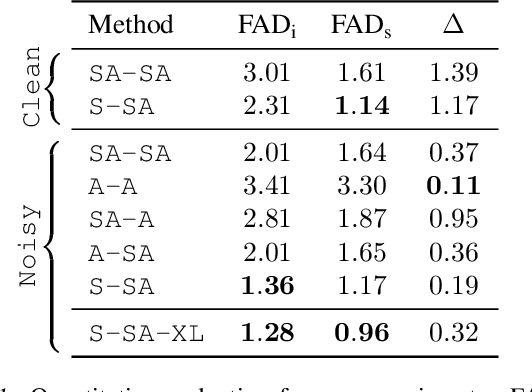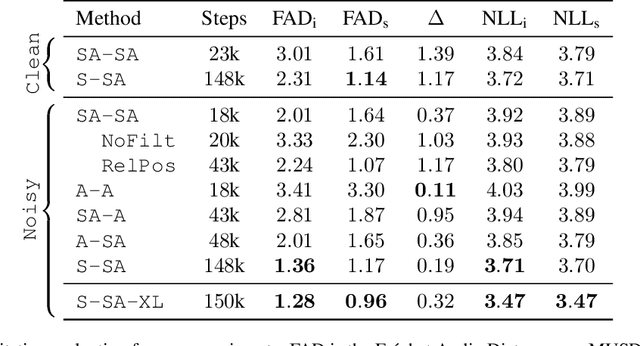Adam Roberts
ReaLJam: Real-Time Human-AI Music Jamming with Reinforcement Learning-Tuned Transformers
Feb 28, 2025Abstract:Recent advances in generative artificial intelligence (AI) have created models capable of high-quality musical content generation. However, little consideration is given to how to use these models for real-time or cooperative jamming musical applications because of crucial required features: low latency, the ability to communicate planned actions, and the ability to adapt to user input in real-time. To support these needs, we introduce ReaLJam, an interface and protocol for live musical jamming sessions between a human and a Transformer-based AI agent trained with reinforcement learning. We enable real-time interactions using the concept of anticipation, where the agent continually predicts how the performance will unfold and visually conveys its plan to the user. We conduct a user study where experienced musicians jam in real-time with the agent through ReaLJam. Our results demonstrate that ReaLJam enables enjoyable and musically interesting sessions, and we uncover important takeaways for future work.
Training LLMs over Neurally Compressed Text
Apr 04, 2024



Abstract:In this paper, we explore the idea of training large language models (LLMs) over highly compressed text. While standard subword tokenizers compress text by a small factor, neural text compressors can achieve much higher rates of compression. If it were possible to train LLMs directly over neurally compressed text, this would confer advantages in training and serving efficiency, as well as easier handling of long text spans. The main obstacle to this goal is that strong compression tends to produce opaque outputs that are not well-suited for learning. In particular, we find that text na\"ively compressed via Arithmetic Coding is not readily learnable by LLMs. To overcome this, we propose Equal-Info Windows, a novel compression technique whereby text is segmented into blocks that each compress to the same bit length. Using this method, we demonstrate effective learning over neurally compressed text that improves with scale, and outperforms byte-level baselines by a wide margin on perplexity and inference speed benchmarks. While our method delivers worse perplexity than subword tokenizers for models trained with the same parameter count, it has the benefit of shorter sequence lengths. Shorter sequence lengths require fewer autoregressive generation steps, and reduce latency. Finally, we provide extensive analysis of the properties that contribute to learnability, and offer concrete suggestions for how to further improve the performance of high-compression tokenizers.
Gemma: Open Models Based on Gemini Research and Technology
Mar 13, 2024



Abstract:This work introduces Gemma, a family of lightweight, state-of-the art open models built from the research and technology used to create Gemini models. Gemma models demonstrate strong performance across academic benchmarks for language understanding, reasoning, and safety. We release two sizes of models (2 billion and 7 billion parameters), and provide both pretrained and fine-tuned checkpoints. Gemma outperforms similarly sized open models on 11 out of 18 text-based tasks, and we present comprehensive evaluations of safety and responsibility aspects of the models, alongside a detailed description of model development. We believe the responsible release of LLMs is critical for improving the safety of frontier models, and for enabling the next wave of LLM innovations.
A Pretrainer's Guide to Training Data: Measuring the Effects of Data Age, Domain Coverage, Quality, & Toxicity
May 22, 2023



Abstract:Pretraining is the preliminary and fundamental step in developing capable language models (LM). Despite this, pretraining data design is critically under-documented and often guided by empirically unsupported intuitions. To address this, we pretrain 28 1.5B parameter decoder-only models, training on data curated (1) at different times, (2) with varying toxicity and quality filters, and (3) with different domain compositions. First, we quantify the effect of pretraining data age. A temporal shift between evaluation data and pretraining data leads to performance degradation, which is not overcome by finetuning. Second, we explore the effect of quality and toxicity filters, showing a trade-off between performance on standard benchmarks and risk of toxic generations. Our findings indicate there does not exist a one-size-fits-all solution to filtering training data. We also find that the effects of different types of filtering are not predictable from text domain characteristics. Lastly, we empirically validate that the inclusion of heterogeneous data sources, like books and web, is broadly beneficial and warrants greater prioritization. These findings constitute the largest set of experiments to validate, quantify, and expose many undocumented intuitions about text pretraining, which we hope will help support more informed data-centric decisions in LM development.
UniMax: Fairer and more Effective Language Sampling for Large-Scale Multilingual Pretraining
Apr 18, 2023



Abstract:Pretrained multilingual large language models have typically used heuristic temperature-based sampling to balance between different languages. However previous work has not systematically evaluated the efficacy of different pretraining language distributions across model scales. In this paper, we propose a new sampling method, UniMax, that delivers more uniform coverage of head languages while mitigating overfitting on tail languages by explicitly capping the number of repeats over each language's corpus. We perform an extensive series of ablations testing a range of sampling strategies on a suite of multilingual benchmarks, while varying model scale. We find that UniMax outperforms standard temperature-based sampling, and the benefits persist as scale increases. As part of our contribution, we release: (i) an improved and refreshed mC4 multilingual corpus consisting of 29 trillion characters across 107 languages, and (ii) a suite of pretrained umT5 model checkpoints trained with UniMax sampling.
The Flan Collection: Designing Data and Methods for Effective Instruction Tuning
Feb 14, 2023



Abstract:We study the design decisions of publicly available instruction tuning methods, and break down the development of Flan 2022 (Chung et al., 2022). Through careful ablation studies on the Flan Collection of tasks and methods, we tease apart the effect of design decisions which enable Flan-T5 to outperform prior work by 3-17%+ across evaluation settings. We find task balancing and enrichment techniques are overlooked but critical to effective instruction tuning, and in particular, training with mixed prompt settings (zero-shot, few-shot, and chain-of-thought) actually yields stronger (2%+) performance in all settings. In further experiments, we show Flan-T5 requires less finetuning to converge higher and faster than T5 on single downstream tasks, motivating instruction-tuned models as more computationally-efficient starting checkpoints for new tasks. Finally, to accelerate research on instruction tuning, we make the Flan 2022 collection of datasets, templates, and methods publicly available at https://github.com/google-research/FLAN/tree/main/flan/v2.
SingSong: Generating musical accompaniments from singing
Jan 30, 2023



Abstract:We present SingSong, a system that generates instrumental music to accompany input vocals, potentially offering musicians and non-musicians alike an intuitive new way to create music featuring their own voice. To accomplish this, we build on recent developments in musical source separation and audio generation. Specifically, we apply a state-of-the-art source separation algorithm to a large corpus of music audio to produce aligned pairs of vocals and instrumental sources. Then, we adapt AudioLM (Borsos et al., 2022) -- a state-of-the-art approach for unconditional audio generation -- to be suitable for conditional "audio-to-audio" generation tasks, and train it on the source-separated (vocal, instrumental) pairs. In a pairwise comparison with the same vocal inputs, listeners expressed a significant preference for instrumentals generated by SingSong compared to those from a strong retrieval baseline. Sound examples at https://g.co/magenta/singsong
MusicLM: Generating Music From Text
Jan 26, 2023



Abstract:We introduce MusicLM, a model generating high-fidelity music from text descriptions such as "a calming violin melody backed by a distorted guitar riff". MusicLM casts the process of conditional music generation as a hierarchical sequence-to-sequence modeling task, and it generates music at 24 kHz that remains consistent over several minutes. Our experiments show that MusicLM outperforms previous systems both in audio quality and adherence to the text description. Moreover, we demonstrate that MusicLM can be conditioned on both text and a melody in that it can transform whistled and hummed melodies according to the style described in a text caption. To support future research, we publicly release MusicCaps, a dataset composed of 5.5k music-text pairs, with rich text descriptions provided by human experts.
Character-Aware Models Improve Visual Text Rendering
Dec 20, 2022



Abstract:Current image generation models struggle to reliably produce well-formed visual text. In this paper, we investigate a key contributing factor: popular text-to-image models lack character-level input features, making it much harder to predict a word's visual makeup as a series of glyphs. To quantify the extent of this effect, we conduct a series of controlled experiments comparing character-aware vs. character-blind text encoders. In the text-only domain, we find that character-aware models provide large gains on a novel spelling task (WikiSpell). Transferring these learnings onto the visual domain, we train a suite of image generation models, and show that character-aware variants outperform their character-blind counterparts across a range of novel text rendering tasks (our DrawText benchmark). Our models set a much higher state-of-the-art on visual spelling, with 30+ point accuracy gains over competitors on rare words, despite training on far fewer examples.
VeLO: Training Versatile Learned Optimizers by Scaling Up
Nov 17, 2022Abstract:While deep learning models have replaced hand-designed features across many domains, these models are still trained with hand-designed optimizers. In this work, we leverage the same scaling approach behind the success of deep learning to learn versatile optimizers. We train an optimizer for deep learning which is itself a small neural network that ingests gradients and outputs parameter updates. Meta-trained with approximately four thousand TPU-months of compute on a wide variety of optimization tasks, our optimizer not only exhibits compelling performance, but optimizes in interesting and unexpected ways. It requires no hyperparameter tuning, instead automatically adapting to the specifics of the problem being optimized. We open source our learned optimizer, meta-training code, the associated train and test data, and an extensive optimizer benchmark suite with baselines at velo-code.github.io.
 Add to Chrome
Add to Chrome Add to Firefox
Add to Firefox Add to Edge
Add to Edge